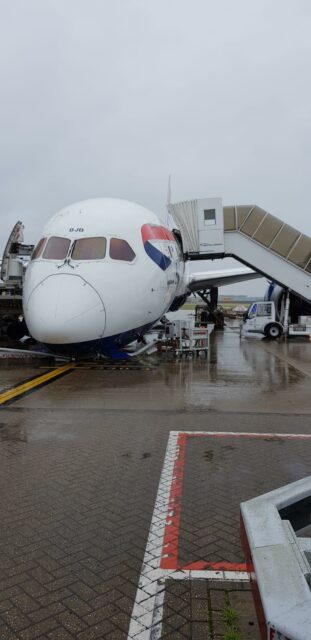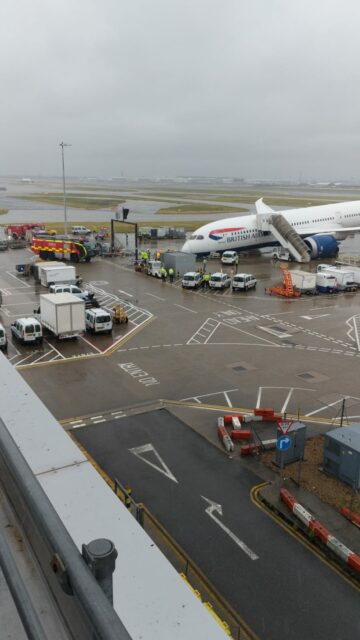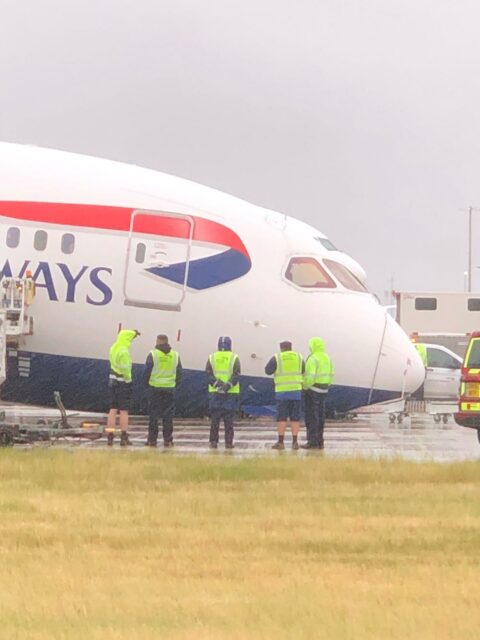BA Boeing 787-8 nosewheel collapse at Heathrow
Early this morning at Heathrow Airport, a British Airways aircraft was reported to have suffered a nose wheel collapse.
Aviation Geek and Plane Spotter M Zulqarnain B quickly posted photographs of the incident.
It doesn’t look good.
The aircraft, a Boeing 787-8 Dreamliner registered G-ZBJB converted from a passenger aircraft to cargo transport, flew into Heathrow from Moscow on Wednesday as British Airways flight 881.
British Airways have already confirmed that no one was injured. The collapse happened while the aircraft was being loaded for a flight to Frankfurt, Germany. Some flight crew were reported to be on board for pre-flight preparations.
The aircraft was parked on stand 583, which JACDEC cites as between Terminal 5C and 3:
According to local airport sources, the incident took place on stand 583, btwn Terminal 5C and 3. pic.twitter.com/KgBg4pys08
— JACDEC (@JacdecNew) June 18, 2021
Heathrow’s fire service was the first to respond and a video being passed around on WhatsApp and Twitter with no attribution shows emergency services staring balefully at the aircraft.
Among calls for speed tape and promises that “it’ll buff right out,” serious guesses as to the cause range from a broken pin to loss of hydraulic pressure to misloading of the aircraft. Vlogger MenTourPilot says that “sources claim” it was a pin mistakenly inserted in a wrong hole during a solenoid change but he has not been able to confirm this.
According to SurreyLive, the Metropolitan Police were also on the scene.
Mysteriously, the Met Police will not answer a question on why its officers were called to Heathrow and has referred us to BA.
The UK Air Accidents Investigation Branch (AAIB) confirmed this afternoon that they have sent a team to London Heathrow Airport in regards to an incident involving an aircraft that suffered a nose landing gear collapse while being loaded with cargo. So far, however, the only information they have released is how the investigative process works.
In the meantime, we can have some fun guessing as to what happened.
I remember living in fear that I might accidentally raise the gear on the Saratoga while on the ground but the AOG (aircraft on ground) weight sensors would stop even the most confused personnel from doing this in a Boeing. The squat switch, as it is called, can fail, however, a sensor failure would default to ON as in on the ground. However, there was a case about ten years ago when an American Airlines Boeing 767-300 nose gear retracted in a hangar during maintenance.
The plane had recently been taken on a test flight following some heavy maintenance. During the flight, a “hydraulic driven generator” failed, leading repair crews to return to the plane after it landed. At some point, the landing gear lever was moved to the “up” position, apparently without any pins having been placed in the landing gear to prevent it from moving.
Many people have commented on how lucky it was that this didn’t happen on landing; however, the chances of the aircraft being able to taxi and take off with this fault seem relatively low.
I’m hopeful we’ll find out what actually happened soon!











737-8 is not a Dreamliner. I think you mean it’s a 787-8
Argh! That’s exactly what I meant. Thanks.
Tis but a scratch.
But seriously, I’m glad nobody was under that thing when it happened.
I imagine a lot of people are being questioned about this.
Yeah the Dreamliner is the 787, this was perhaps a “Nightmareliner”?
For a nose gear to collapse while stationary, being loaded, is a virtual impossibility. Unless due to some mechanical failure. Even then, the probability of this happening is unlikely in the extreme. Pressure on the strut would be downwards, vertical, pushing on a very strong piece of metal. A loss of hydraulic fluid is also a very improbably cause. The main components that carry fluids would be the nosewheel steering and the shock absorbing function. Breaking or disconnection of the steering linkage should not not affect the ability of the strut to support the weight on the strut. There are no brake units on the nosewheel, so no brake fluid. If the fluid (Skydrol?) leaked out of the nose strut, it would just go down but not break.
Likewise, there is no way that the nosewheel could collapse due to wrong loading. Ever seen videos of rough landings, where an aircraft settles heavily on its nosewheel? It rarely leads to the whole shebang breaking, not even under the extreme stress of a hard landing.
An incident like this should not lead to the involvement of the Metropolitan police. Unless …..
Well, this raises more questions.
And I remember a word of wisdom, an old saying: “One fool can ask more questions than ten wise men can answer”.
Maybe we will hear from one of these wise men to tell us what actually happened.
I found a similar, older incident (March 4th 2016) with the same type on the Aviation Herald:
If anything like that has happened here, BA may well have called the police to secure evidence?
Mendel,
You may be right but it is ominous that the Met was called.
At most airports, the so-called “airport police” are not real police in the sense that they don’t have the power of arrest and other rights that are restricted to, well, police officers.
In Ireland the real police are called Gardai – guards.
So here, a guard is a policeman or -woman.
The word “police” on a uniform means… a guard.
Yes, things can be a wee bit complex in Ireland.
On the other hand, airport police generally are trained to very high standards and have of course more specialised experience with matters regarding aviation.
As expert witnesses, I would have thought that they are as good as, if not better than the regular police.
Unless, of course, the investigation is moving towards a criminal nature, because that would be outside of the airport police’s jurisdiction.
A niggling thought: There have been many problems with the Dreamliner, some seem connected with a change in the philosophy of Boeing, a suggestion that it has shifted focus from quality to efficiency and, as a result, on profitability. Some airlines even – I read somewhere – refuse to take delivery of aircraft that have been built at the Charleston plant.
Is this another indication of the suspected decline of Boeing as a trusted manufacturer of superb, and superbly engineered, aircraft?
I surely hope not. Under normal circumstances a manufacturer of the size and reputation of Boeing would have put a lot of effort and resources into correcting any of those problems (assuming, of course, that they exist. I must hasten to add, before a team of lawyers jump on me, that this entry is purely speculative from my side).
But the circumstances are not normal. Aviation is barely able to keep on its feet. International air travel is still restricted. The new covid-19 Delta variant is putting new pressure on the re-opening of business and travel. Here, Aer Lingus is teetering on the brink. IAG, its parent company, has heavy losses to absorb and must be under enormous financial pressure. The funds to save British Airways must be running low, if not running out. There may not be enough to keep some of the smaller companies in the IAG group afloat. Aer Lingus still owns a large number of slots at Heathrow. There may well be a temptation to jettison Aer Lingus and hand those slots to BA.
With all this in the background, many aircraft are still sitting on the ground undelivered. And I only mentioned IAG. The 737 Max problem had not yet been solved when covid struck. There is no doubt in my mind that this has created a “domino effect” that is still affecting aviation worldwide.
Even if the covid-19 measures were lifted overnight, the effects will still linger for years to come.
“Aviation is barely able to keep on its feet.”
Or gear – or not! ;-)
I don’t know if people have seen the write up, but the suggestion is that there was a “short” engineer who couldn’t reach to put a pin in the nose-gear, and had an untrained, taller colleague do it, instead of getting a ladder. The pin was put in the wrong hole, and the maintenance/test of the hydraulic system then led to the collapse.
I’ve not yet found the official report, but here is a press link https://www.thewashingtontime.com/ba-jet-collapsed-at-heathrow-because-mechanic-was-too-short-to-correctly-put-locking-pin-in-place
The final report is still outstanding but they’ve released a special bulletin with the main info (UK doesn’t do a preliminary report as standard like the US does). Thanks for this, I’m sure I would have missed it.
Bulletin https://assets.publishing.service.gov.uk/media/60ed9e3be90e0764d1be271a/AAIB_Special_Bulletin_S1-2021_G-ZBJB.pdf very interesting in that it shows the two holes right next to each other, and it does seem an easy mistake to make. The retrofit of a blanking plug on the incorrect apex bore seems very sensible.
I disagree. It’s only an easy mistake to make if you’re not thinking about what you’re doing; otherwise it’s perfectly clear that installing a round pin in the eye of a hinge is not going to lock that hinge in any way. If you don’t understand this, you have no business being a mechanic.
100% agree it’s obvious if you stop to think, but as these pages frequently show, avoiding accidents is often about not depending on “common sense” or people thinking about what they are doing…